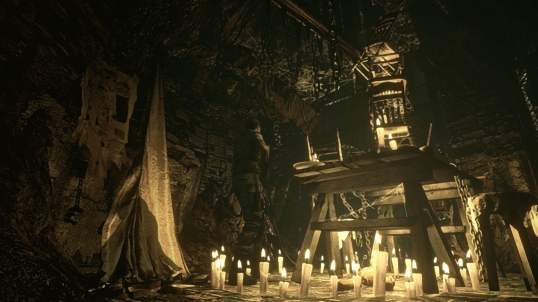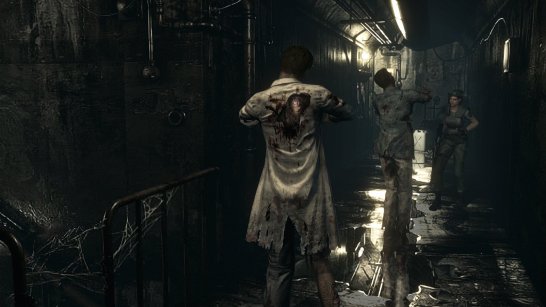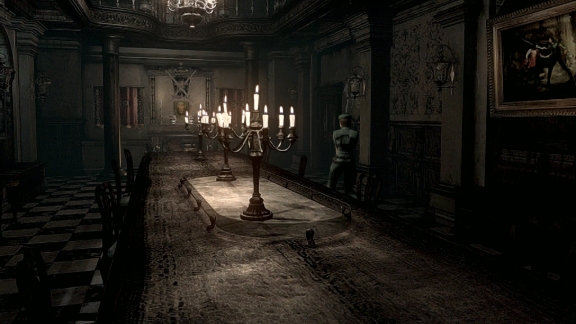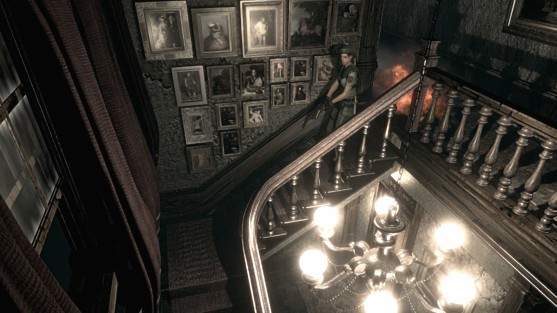Take a trip to Racoon City for Harrison’s break down of what made Resident Evil stand out.
Those who know me have probably heard an awful lot of pretentious babbling about why Resident Evil 4 is the greatest game ever made. From incredible level design, to memorable boss battles and immensely satisfying combat, it’s a game that does just about everything right. But the more observant among you will have noticed that that is not the game I am recommending today. Nor will I be recommending it at any point in this series.
‘Why?’ you ask (Although I may be overestimating how much you care). Well the reason that Resident Evil 4, the best game in the franchise by a mile, is not the subject of discussion today is because it’s not really a horror game. It has scary elements for sure, and it’s unbearably intense at times, but realistically it feels much more like an action-adventure release than a proper horror title. In fact, you’ll probably notice that some die-hard Resifans resent the game, as it is often cited as the moment where the franchise began to loose touch with its roots.
But you can’t do a protracted horror feature without at least making a passing reference to the genre’s most famous golden goose. After all, Resident Evil popularised horror gaming, and is basically the reason that I fell in love with the art-form in the first place. Sure, there are horror games that pre-date the franchise (Alone in the Dark, Clocktower, Sweet Home), but this is the first one that was really any good and it established 90 percent of the conventions that came to define the genre in the following decade.
Every trope- from limited ammo and health supplies, to the curious emphasis on riddles and exploration and even fixed camera angles-started with this game. This is the real genesis of what we call ‘survival horror’. For those who don’t know, ‘survival horror’ is the best kind of spooky gaming experience that you can get. It’s a sub-genre that towers above all others, including action-horror, stealth-horror, stalker-horror, and first-person horror. The reason for this, is simply because it has the best pedigree out of any of them.

You see, there was a time when survival horror was producing hit-after-hit, with industry titans Silent Hill and Resident Evil both leading the charge. By the way, in case you were not aware, Silent Hill and Resident Evil are generally accepted to be THE definitive horror games. If you ask most people to pick the best franchises in gaming, you can almost guarantee that at least one of those two will come up. So it goes without saying, that when they were at the height of their powers, it was a wonderful time for horror. Ergo, when you talk about the golden age of horror games, you’re basically talking about a time when these two franchises were reigning supreme, and by extension, a time when survival horror was dominant.
So what constitutes survival horror exactly? Well I’ll break it down for you, and I’ll use the first Resident Evil as an exemplar specimen. First and foremost, the sub-genre is primarily concerned with a unique brand of tactical combat that prioritises efficiency, carefulness and supply conservation. These games are brutal with their health and ammo, and Resident Evil is no exception in this regard. The go to strategy is therefore to avoid combat as much as possible. Notice however, that combat is still a core element of the survival horror game. These titles will at some point require you to go toe-to-toe with your enemies, unlike say Outlast or Amnesia. Still, they’re not outright action games either, and won’t allow you to go in guns blazing. It’s a delicate balancing act that Resident Evil executes flawlessly; giving you the mentality of a hardened survivor, rather than a useless victim or overpowered super soldier.
Being considerate with supplies is thus the key gameplay mechanic, as well as general inventory management. Indeed, you’ll only be able to hold so much at a time, requiring you to choose your items wisely. Resident Evil even goes as far as to make mandatory items like keys and puzzle objects take up space, which means that you can only ever take a limited amount of firepower with you. If this sounds restrictive or harsh, that’s because it is, and it also makes things unbearably risky. Every time you enter a new area, you wont know if you’re adequately equipped for it, in fact, for all you know, there could be a boss battle just around the corner.

One area in which Resident Evil does admittedly go a little overboard is with dictating the amount of saves that you can have, as you are forced to use a limited amount of ‘Ink Ribbons’ in order to record your progress on a typewriter. I mean, I’m all for punishing difficulty, but sometimes I just need to save because I’ve got shit to do elsewhere. I don’t want to feel like I’m at a disadvantage because I used one of my ribbons when I needed to pop down to the shops.
Another convention of survival horror is the distinctive use of setting. Games in this genre will typically be set in a handful of locations, ones in which you will feel confined and imprisoned. You will then backtrack around these labyrinthine areas, looking for keys to doors, that then lead to keys for other doors, that then lead to keys for other doors, and so on. It means that you’re constantly travelling back and forth across a single area, unlocking more of it piece by piece.
In Resident Evil, that setting is the infamous Spencer Mansion. Whoever the architect of this place was, he had one hell of a job to do. Areas are blocked off for all kinds of reasons, be it that you need to locate objects to slot into holes (oo-er), find keys to open doors, or solve obtuse puzzles in order to unveil secret passages. I have no idea how the original owners got around, if they wanted to visit the garden they’d first have to find 4 separate keys, 2 different emblems, a sheet of classical music, 4 ornate masks, a specific lever, and some jewels. Then I guess they’d have to put them all back in their original places when they were done. They must have, because that’s where we find them.
Again, this might sound like a lot of hassle, but it is perhaps the game’s greatest strength. You get to learn every brick of this mansion by the time you’re done, and you become familiar with all the short-cuts and dead-ends. As a result, every locked door will gnaw insistently at your brain and you won’t be able to let it go. You’ll have to get through there. You’ll need to know what’s on the other side, and when you finally get to it, the reward will feel thoroughly earned. It just appeals to the completionist sensibility in all of us, as you check off each room of the mansion one by one. The backtracking also helps the pacing of the experience immensely, as you gradually peel back layer after layer of the environment, uncovering new mysteries and new threats.

I’d take a well designed single location like this any day of the week over a bland and empty open world. The Spencer Mansion is a creepy ass residence with a boatload of charm and hidden intricacies. This is one of the things that I miss the most about old-school horror gaming.
Survival Horror also revolves quite heavily around complex puzzle solving, something which is certainly front-and-centre here. And these are no simple filler puzzles either, this stuff requires you to think outside of the box. In fact, scrap the box altogether, some of these conundrums would leave the fucking Riddler scratching his head! Half the time you’ll be trying to come up for a solution for hours, only to realise that you don’t even have the required tools yet. Once again, I’m sure that this probably sounds off-putting, but you soon get into the swing of things, and you’ll appreciate the way that the puzzles break up the scares. After all, what’s the point of them being there if they aren’t going to challenge you?
Oh and as for scares, survival horror games usually employ a very specific type of threat. It’s less about being hunted by a ghost or sneaking around maniacs in the dark, and more about fighting off a variety of diverse creatures. In Resident Evil’s case, the monsters are all the result of genetic experiments occurring in a lab beneath the mansion. They come in a plethora of different forms, from zombies (before they were in everything), to giant spiders and mutant reptiles. They all behave in different ways and have their unique abilities, which keeps combat feeling fresh and interesting. Indeed, you’ll never encounter too many of the same enemy type. The bosses are also pretty great, especially if you pick up the 2002 remake, which features the absolutely terrifying Lisa Trevor.
The remake also introduces a neat little twist on the standard zombie enemies, in the form of the imaginative crimson head creatures. These are effectively super-zombies, with their name deriving from the red pigmentation of their skin. They’re fast, strong, and very hard to kill. The gimmick with these creatures, is that they only appear after you’ve killed a traditional zombie. If you return to an area in which you previously put down one of the undead, then there’s a chance that it may be up and walking again, now as an upgraded crimson head. The only insurance you have to prevent this, is to either burn zombie corpses with a lighter (which has a limited supply of oil), or to pull off a headshot, which is tricky with the fixed camera angle perspective.
This changes the entire game, as you’re never sure if you should risk killing a zombie, just in case you have to return to the area again later. It creates a wonderfully scary dynamic, where you’re constantly worrying about your oil, your bullets, and the monsters heading towards you. It’s a genuine predicament; do you leave the zombie be, do you kill it and use up some of your lighter fluid, or do you gamble and hope that he wont turn into something worse later?
You’ll try your best to ensure that you never have to deal with the crimson heads, but I promise you that you’ll fail. And that’s a good thing, because the constant fear that they might show up, makes for one of the most exhilarating experiences in any video-game.

Survival Horror is also by far the most heavily directed style of horror game. What I mean by this, is that all of the scares are pre-meditated and designed under very precise conditions. To many modern day gamers, this may sound like a bad thing, but it really isn’t. Random encounters are grossly overrated, and unscripted scares are never going to be as effective as the work of a true master. Honestly, I don’t mind getting a very linear experience, if it’s one that has been crafted with the utmost attention to detail and care. Resident Evil is again an exemplary instance of this, with almost every moment being an iconic fright that never fails to deliver. There’s so many legendary scenes in this game, like the unforgettable initial zombie attack, or the bit where the dog jumps through the window.
It’s so good to have a game this meticulously designed, as it means that you get the optimum experience desired by the developers. It’s for this same reason that the fixed camera angles work so well, instead of hindering your enjoyment. Each change in perspective is entirely deliberate and has a specific purpose, be it to guide you to a specific item, or set you up for a really good jump scare. It also plays with your perspective in interesting ways, by keeping enemies obscured and out of sight, or tricking you into thinking that something is behind you, when it’s actually a reflection in a mirror.
In short, Resident Evil is a textbook example of a great survival horror game. It has deep gameplay, intricate design, and a suitably intense combat system. Most importantly of all though, it is more than capable of delivering a good scare.
Well, that’s our penultimate entry taken care of! You can’t get much better than this masterpiece. Having said that, I have saved the best for last….
RECOMMENDATION: FOR THOSE WHO WANT TO IMMERSE THEMSELVES IN CLASSIC SURVIVAL HORROR AND SEE WHERE IT ALL BEGAN. ALSO A DECENT PICK FOR FANS OF B-MOVIES, CREATURE FEATURES AND ZOMBIE FILMS.
RATINGS:
ORIGINAL- 8/10
REMAKE- 9/10